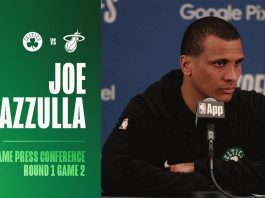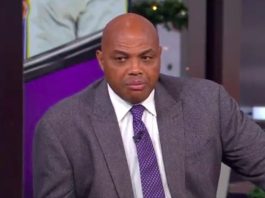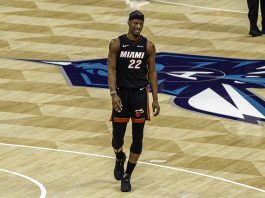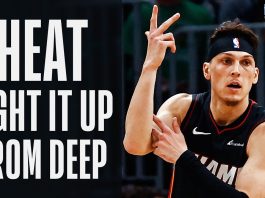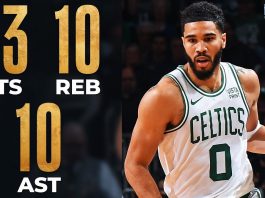The Boston Celtics have succeeded against the streak this season as underdogs, on the road, and without rest. But the most glowing success the Celtics had up to suspension of play was their record ATS with rest—10-1-1, for a cover rate of 90.9 percent.
Ample rest for veteran All-Star Kemba Walker and former All-Star Gordon Hayward has paid dividends for Boston. These key players both sit on the wrong side of 30 years old, and have had multiple injuries throughout their careers.
If rest has equaled success in the regular season for this Celtics squad, maybe four-and-a-half months of rest will push them to the top of the playoff run. With a strong core but an inconsistent second unit, this bizarre year could be the perfect time for a top-heavy team like this to make some noise when it matters the most.
Prior to COVID putting a screeching halt to the NBA season, the Boston Celtics were impressing the people who make NBA expert picks, whether they were underdogs, on the road, or with no rest, they prevailed with awesome win-loss records. But their most impressive record of all has been their record against the streak with rest—they top the league at 10-1-1 against the streak with rest time in between games, good for a 90.9 percent cover rate.
The Green have hovered around the top of the Eastern Conference standings all season, but they have never really entered the conversation of ‘legitimate contenders’ reserved for the likes of Milwaukee and both Los Angeles squads. But could the most in-season rest of any season in league history—in the form of a four-and-a-half month, pandemic-forced stoppage of play—be the secret weapon for these Celtics?
Good for the Bones—and the Older Guys
Many factors go into Boston’s trend of winning—or at least covering—with rest between games. For one, veteran All-Star point guard and first-year Celtic Kemba Walker plays more energized when he’s been able to rest one or two days. The undeniable leader and big shot-maker of the squad, Walker has battled lingering knee issues since the start of the year.
Boston will need Walker healthy and thriving if they expect to make some noise this summer. The four-time All-Star is averaging 21.2 points, 4.9 assists, and 4.1 rebounds per game this season, and shooting 37.7 percent from deep and 86.7 percent from the line.
Another player who benefits from rest time is second-year Celtic and former Utah Jazz All-Star Gordon Hayward, who has battled injuries since his first regular-season game in green. His horrific fractured ankle and tibia on opening night in Cleveland on October 17, 2017 set the stage for a bumpy road with his second NBA franchise. After a year away from the court, his first season post-rehab was riddled with ankle issues, and he has suffered concussions, broken noses, a broken left hand, and multiple other bumps and bruises since.
However, the ten-year vet was just starting to look a little more like his vintage self around the time that play stopped. He was putting up 17.3 points, 6.5 rebounds, and 4.1 assists a game and shooting 50.2 percent from the field, 39.2 percent from three, and 84.7 percent from the line. He clearly exhibited more burst with rest than he did on the second night of a back-to-back or second game in three days.
Not many teams will benefit more from the rest of the last few months than the Celtics. Knowing their work ethics and dedication, these two core players on the wrong side of 30 years old have undoubtedly stayed in shape for the July 31 return date. Their success with rest could very well translate to success post-hiatus.
Playoffs are for the Big Guns
Success with rest can also be attributed to a strong core group of players. This Boston Celtics team was an NBA public betting favorite to advance in the playoffs and was initially considered quite deep in the preseason, actually turned out to be quite top-heavy. With an inconsistent big man tandem and little scoring punch on the bench, they need to ride their stars to success.
That has meant big minutes and big production from Walker and breakout stars Jayson Tatum, Jaylen Brown, and Marcus Smart. Tatum, in his second year, made his first All-Star game in February and looked poised for an All-NBA selection. Brown, in his third year, had improved leaps and bounds on both sides of the floor and looked like a contender for Most Improved. And Smart had fully emerged as one of the most underrated floor generals and arguably the best defensive guard in the league.
But beyond those four and the reliable-when-healthy Hayward, the Celtics left a lot to be desired. That core five combined to average a whopping 96 of the team’s 113 points per game on the season.
When your five main guys account for nearly 85 percent of your team’s points production, you may need rest between games to succeed in a playoff run. Boston’s second unit struggles with shooting, pace, and taking care of the ball. They cannot rest their main stars simultaneously in meaningful games—they will barely be able to rest them at all in close elimination playoff games.
A Good Trend in a Weird Year
Plain and simple, Boston would seem to be one or two pieces away from title contention in a normal season and playoff run. But as we all know, this year is not normal whatsoever.
The Celtics veterans, those with various injury concerns, and the young guns with high usage rates all benefit from this long stretch away from competitive action. With hard work, continued core chemistry, and a few lucky breaks, they may just translate their success with ample rest between games into success with four-plus months off toward the end of the season.
Don’t be surprised if the wrath of COVID ends up the luck of the Irish in the coming months.

